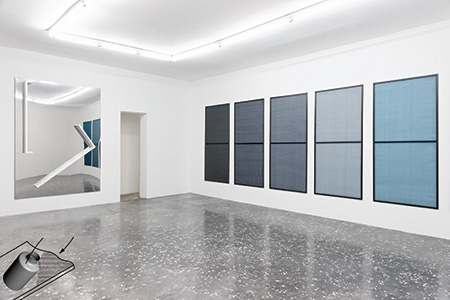Artie Vierkant

Artie Vierkant’s exhibition at New Galerie was introduced with a trailer that appeared on the gallery’s website before the opening. The video was a corporate-style animation sequence of transitioning diagrams, instructional arrows and CAD modulations, with a soundtrack of the kind of weakly emotive synthesizer music used in cheap online advertisements. The trailer, of course, was neither a whole-hearted promotional gesture, nor did it clearly reference Vierkant’s work in the exhibition, entitled ‘US 6318569 B1, US 8118919 B1; (Exploits)’. Perhaps most of all, it suggested the embeddedness of the young, New York-based artist’s practice within commercial mediations and online interfaces.
Vierkant’s most recent works – the first iteration of his ongoing series of ‘Exploits’ – are based on intellectual property legislation and the patent licenses required for manufactured objects and certain design processes. His ‘Exploits’ peek into a world of bedroom innovators and professional entrepreneurs, all hoping to one day sell their unique concept to a wider pool of commercial industries. This is a micro-world of patents that is governed and protected by license terms that include territorial rights for reproduction, colour palettes, material compositions and an endless list of other minutiae. Vierkant’s ‘Exploits’ result from the artist’s own direct negotiations with a number of patent holders to produce what he calls ‘fabrications’, which represent the realization of the patented products and their negotiated derivation as art works.
At New Galerie, Vierkant presented seven works from the ‘Exploits’ series, which he developed from two registered patents: a detachable magnetic storage rack suitable for domestic kitchens, and an organza air filter for windows that minimizes the effects of UV light, pollen and other allergens. The exhibition’s title ‘US 6318569 B1, US 8118919 B1; (Exploits)’ took its name from the US patent number of these provocative yet banal products. Their implied interiority (one for use in the kitchen, the other for blocking out external environmental effects), as well as their function as support structures for presentation (a storage space, a window frame), however, are somehow analogous to the interior artistic circuitry of production and presentation that Vierkant sets for himself.
In the upstairs gallery, Detachable storage rack for a metallic structure 1 (Exploit) (all works 2013) had the confident proportions of a Minimalist wall sculpture. Its mirrored metallic surface acted as a baseboard for two white magnetized relief elements, arranged at oblique angles so as to diminish any reference to their latent function as pieces of a storage rack. Vierkant’s arrangements of these elements also willingly introduced the art-historical precedents of structural abstraction, from Kazimir Malevich to Donald Judd to Liam Gillick. Another iteration of the same patent, Detachable storage rack for a metallic structure 2 (Exploit), applied the same elements differently. In this case, a single blue rack stretched the vertical length of its metallic supporting surface and was installed low on the gallery wall. The variety in the scales of the structures and the colours of their magnetized rack elements suggested the elasticity within the particular terms of the patent license.
The second patent provided Vierkant with a similar range of interpretative limits. Air filter and method of constructing same 6, Six Screen Ascending Blue (Exploit) operated within the patent’s specificities of frame, mesh and fabric, but evidently allowed the artist to play with colour and format. Vierkant presented a six-panel variation of blue screens that ran like a colour palette across the gallery’s back wall. Downstairs, the same patent was applied to more singular coloured forms.
For each of the two licenses, Vierkant agreed with the patent holders that he would be allowed to produce up to 75 works over the course of the series. With legal negotiation at the heart of ‘Exploits’, one might assume that Vierkant’s priorities exist somewhere within the Conceptualist doxa of testing or affirming the limits by which objects become sanctioned and possessed by definitions other than those that art holds for itself. Yet Vierkant’s work goes even further to implicate commercial objects and their circulations – most significantly, the governance that dictates their very becoming.














